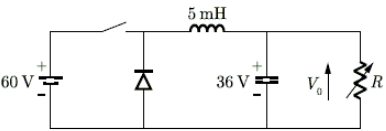Electronics and Communication Engineering (ECE) Exam > Electronics and Communication Engineering (ECE) Questions > A buck converter that feeds a variable resist...
Start Learning for Free
A buck converter that feeds a variable resistive load is shown in the figure. The switching frequency of the switch S is 100 kHz and the duty ratio is 0.6. The output voltage V0 is 36 V. Assume that all the components are ideal and the output voltage is ripple-free. The value of R (in Ohm) that will make the inductor current (iL) just continuous is (Answer up to the nearest integer)

Correct answer is '1250'. Can you explain this answer?
Verified Answer
A buck converter that feeds a variable resistive load is shown in the ...
Given circuit is

Also, we have
fo = 100 kHz
Duty cycle = 0.6
Vo = 36 V
When switch is ON, then
Vs = Vo + Ldi/dt or Ldi/dt = Vs - Vo


At critical value, ∆IL = I0/2, we have

Hence, R = 1250 Ω
Most Upvoted Answer
A buck converter that feeds a variable resistive load is shown in the ...
Given circuit is

Also, we have
fo = 100 kHz
Duty cycle = 0.6
Vo = 36 V
When switch is ON, then
Vs = Vo + Ldi/dt or Ldi/dt = Vs - Vo


At critical value, ∆IL = I0/2, we have

Hence, R = 1250 Ω

|
Explore Courses for Electronics and Communication Engineering (ECE) exam
|

|
Similar Electronics and Communication Engineering (ECE) Doubts
Question Description
A buck converter that feeds a variable resistive load is shown in the figure. The switching frequency of the switch S is 100 kHz and the duty ratio is 0.6. The output voltage V0 is 36 V. Assume that all the components are ideal and the output voltage is ripple-free. The value of R (in Ohm) that will make the inductor current (iL) just continuous is (Answer up to the nearest integer)Correct answer is '1250'. Can you explain this answer? for Electronics and Communication Engineering (ECE) 2025 is part of Electronics and Communication Engineering (ECE) preparation. The Question and answers have been prepared according to the Electronics and Communication Engineering (ECE) exam syllabus. Information about A buck converter that feeds a variable resistive load is shown in the figure. The switching frequency of the switch S is 100 kHz and the duty ratio is 0.6. The output voltage V0 is 36 V. Assume that all the components are ideal and the output voltage is ripple-free. The value of R (in Ohm) that will make the inductor current (iL) just continuous is (Answer up to the nearest integer)Correct answer is '1250'. Can you explain this answer? covers all topics & solutions for Electronics and Communication Engineering (ECE) 2025 Exam. Find important definitions, questions, meanings, examples, exercises and tests below for A buck converter that feeds a variable resistive load is shown in the figure. The switching frequency of the switch S is 100 kHz and the duty ratio is 0.6. The output voltage V0 is 36 V. Assume that all the components are ideal and the output voltage is ripple-free. The value of R (in Ohm) that will make the inductor current (iL) just continuous is (Answer up to the nearest integer)Correct answer is '1250'. Can you explain this answer?.
A buck converter that feeds a variable resistive load is shown in the figure. The switching frequency of the switch S is 100 kHz and the duty ratio is 0.6. The output voltage V0 is 36 V. Assume that all the components are ideal and the output voltage is ripple-free. The value of R (in Ohm) that will make the inductor current (iL) just continuous is (Answer up to the nearest integer)Correct answer is '1250'. Can you explain this answer? for Electronics and Communication Engineering (ECE) 2025 is part of Electronics and Communication Engineering (ECE) preparation. The Question and answers have been prepared according to the Electronics and Communication Engineering (ECE) exam syllabus. Information about A buck converter that feeds a variable resistive load is shown in the figure. The switching frequency of the switch S is 100 kHz and the duty ratio is 0.6. The output voltage V0 is 36 V. Assume that all the components are ideal and the output voltage is ripple-free. The value of R (in Ohm) that will make the inductor current (iL) just continuous is (Answer up to the nearest integer)Correct answer is '1250'. Can you explain this answer? covers all topics & solutions for Electronics and Communication Engineering (ECE) 2025 Exam. Find important definitions, questions, meanings, examples, exercises and tests below for A buck converter that feeds a variable resistive load is shown in the figure. The switching frequency of the switch S is 100 kHz and the duty ratio is 0.6. The output voltage V0 is 36 V. Assume that all the components are ideal and the output voltage is ripple-free. The value of R (in Ohm) that will make the inductor current (iL) just continuous is (Answer up to the nearest integer)Correct answer is '1250'. Can you explain this answer?.
Solutions for A buck converter that feeds a variable resistive load is shown in the figure. The switching frequency of the switch S is 100 kHz and the duty ratio is 0.6. The output voltage V0 is 36 V. Assume that all the components are ideal and the output voltage is ripple-free. The value of R (in Ohm) that will make the inductor current (iL) just continuous is (Answer up to the nearest integer)Correct answer is '1250'. Can you explain this answer? in English & in Hindi are available as part of our courses for Electronics and Communication Engineering (ECE).
Download more important topics, notes, lectures and mock test series for Electronics and Communication Engineering (ECE) Exam by signing up for free.
Here you can find the meaning of A buck converter that feeds a variable resistive load is shown in the figure. The switching frequency of the switch S is 100 kHz and the duty ratio is 0.6. The output voltage V0 is 36 V. Assume that all the components are ideal and the output voltage is ripple-free. The value of R (in Ohm) that will make the inductor current (iL) just continuous is (Answer up to the nearest integer)Correct answer is '1250'. Can you explain this answer? defined & explained in the simplest way possible. Besides giving the explanation of
A buck converter that feeds a variable resistive load is shown in the figure. The switching frequency of the switch S is 100 kHz and the duty ratio is 0.6. The output voltage V0 is 36 V. Assume that all the components are ideal and the output voltage is ripple-free. The value of R (in Ohm) that will make the inductor current (iL) just continuous is (Answer up to the nearest integer)Correct answer is '1250'. Can you explain this answer?, a detailed solution for A buck converter that feeds a variable resistive load is shown in the figure. The switching frequency of the switch S is 100 kHz and the duty ratio is 0.6. The output voltage V0 is 36 V. Assume that all the components are ideal and the output voltage is ripple-free. The value of R (in Ohm) that will make the inductor current (iL) just continuous is (Answer up to the nearest integer)Correct answer is '1250'. Can you explain this answer? has been provided alongside types of A buck converter that feeds a variable resistive load is shown in the figure. The switching frequency of the switch S is 100 kHz and the duty ratio is 0.6. The output voltage V0 is 36 V. Assume that all the components are ideal and the output voltage is ripple-free. The value of R (in Ohm) that will make the inductor current (iL) just continuous is (Answer up to the nearest integer)Correct answer is '1250'. Can you explain this answer? theory, EduRev gives you an
ample number of questions to practice A buck converter that feeds a variable resistive load is shown in the figure. The switching frequency of the switch S is 100 kHz and the duty ratio is 0.6. The output voltage V0 is 36 V. Assume that all the components are ideal and the output voltage is ripple-free. The value of R (in Ohm) that will make the inductor current (iL) just continuous is (Answer up to the nearest integer)Correct answer is '1250'. Can you explain this answer? tests, examples and also practice Electronics and Communication Engineering (ECE) tests.

|
Explore Courses for Electronics and Communication Engineering (ECE) exam
|

|
Signup to solve all Doubts
Signup to see your scores go up within 7 days! Learn & Practice with 1000+ FREE Notes, Videos & Tests.


























